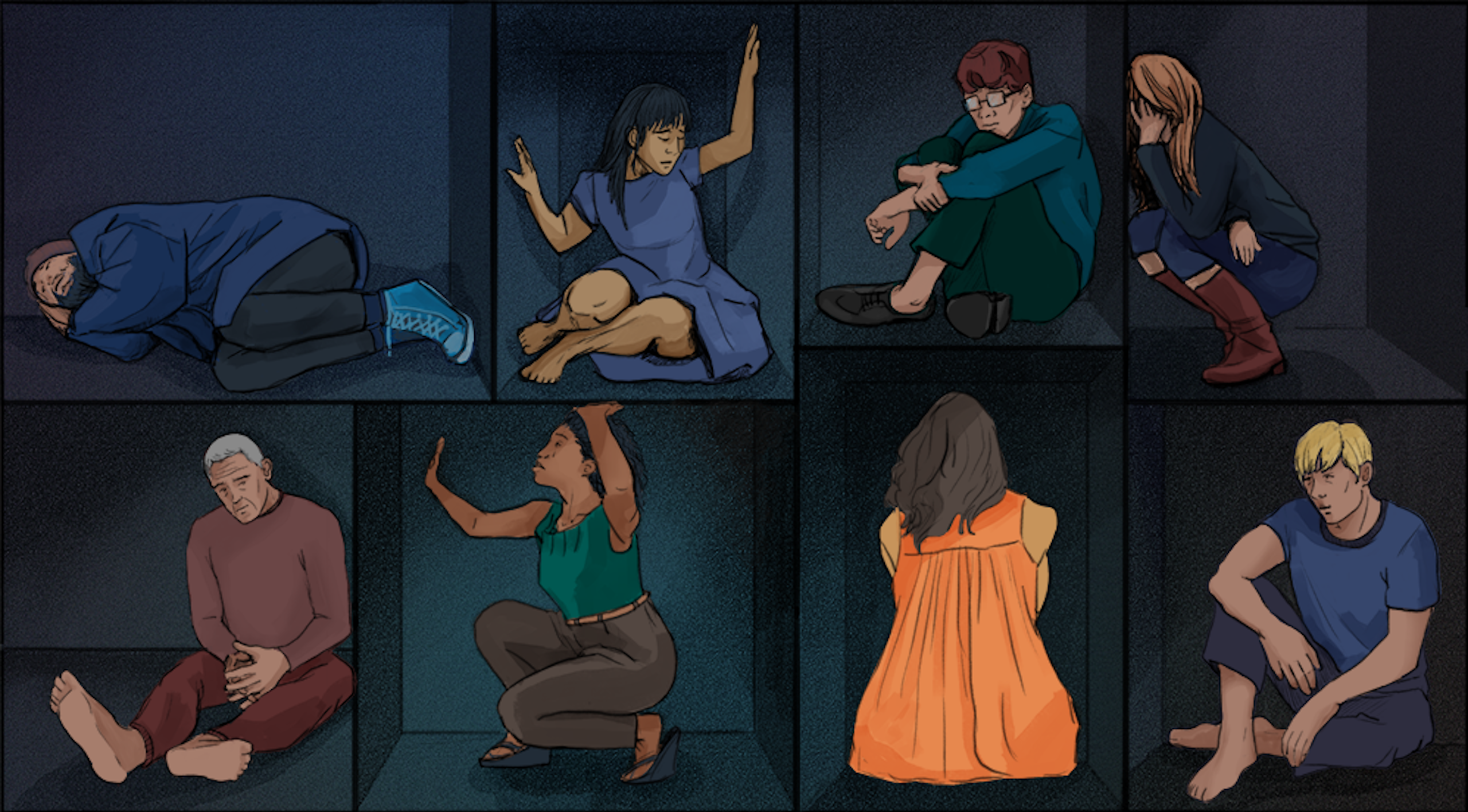
To recover mental health in Denmark, ten years will be too long
- Written by Claire Roney & Edoardo Anziano
- Edited by Zahra Salah Uddin
- Illustration by Charity Atakunda
In Denmark, the number of anxiety and depression medication users is soaring. But when it comes to long-lasting treatment, internationals and locals both continue to suffer in a system endlessly difficult to navigate.
“I felt like I was trapped inside a box – of just a black box. There were people around me and I couldn’t hear them. I couldn’t see them properly. I did nothing […] You’re just alone.”
Jonas Kowalewski had his first anxiety attack when he was six years old. Anxiety is among the most common mental disorders in Denmark, and is the third most common disease overall, according to the Danish National Board of Health.
In 2018, approximately 198,000 children and adults reportedly lived with anxiety and other nervous and stress-related conditions. Depression and other affective disorders followed in second at approximately 135,000 people. The number of users of anxiety and depression medication is the highest among young people between 18 and 24 years old, according to the Danish Health Authority.
The National Board of Health recently released an academic presentation of a 10-year plan to address pervasive problems in the mental healthcare system, in which an estimated 587,000 children and adults currently have a mental illness, although that number is likely underestimated. It is also predicted that 40% to 50% of the total population will have a mental illness in their lifetime.
More than 70 years have passed since the parliament passed the first mental health law, but the system’s problems are still stubbornly the same as before and funding is lacking.
'Massive' costs
“Mental health is declining in Denmark.” This is the opening sentence to the Summary page of the National Board of Health’s 2022 presentation to tackle the inefficiencies of its mental healthcare system in 10 years: “Better mental health and a strengthened effort for people with mental illness” (Better Plan).
The Danish mental healthcare system is riddled with problems, and these are discussed openly in the Better Plan: “Common to the previous initiatives is that they have to a large extent been scattered, incoherent and sporadically implemented through pooled and temporary pilot projects that have not been conceived based on a common professional direction and ambition.”
With its problems, the Better Plan frequently highlights the various costs of mental disorders, summarizing, “The social costs of mental illness are massive.”
Economically, it notes that anxiety itself, “is the cause of most new awards of early retirement and largest costs of lost production,” estimating that the country loses 5.4% gross-domestic-product annually to lost productivity and labor as a result of mental illness, according to the Organization for Economic Co-operation and Development (OECD). Mental disorders are also the cause of approximately 3,500 deaths annually, making it the fourth most common cause of death in Denmark, according to the Better Plan.
Those personally experienced with the Danish mental healthcare system are concerned that the government’s acknowledgment is motivated by economic rather than societal concerns.
“Of course, the government wants to save money where they can save money, but regarding welfare and quality of life for people I don't think that there should be any talk about saving money,” Kowalewski says. “It's not fun living like that because, to be honest, you are just not living your life.”
“They are concerned, that’s what they say, and I think they are concerned, but also because it’s a problem that costs a lot of money,” suggests Mia Kristina Hansen, President of the Danish Association for Mental Health and Kowalewski’s mother.
Although Denmark offers free mental healthcare options, some Danes suggest that these services are difficult to take advantage of, and internationals find these inaccessible due to long wait times and Danish fluency requirements. Alternative options, such as private healthcare, are also problematic, meaning part of the Danish citizenry is not getting help. Investments to improve the situation are, so far, not there. The expenditure for the Danish mental healthcare system is still below the European average.
A never-ending quest
Seeking help from a general practitioner (GP) is often the first step. Danish residents receive free healthcare assistance, and GPs can offer “conversational therapy”, although they are not required to assist people with mental issues. In 2020, almost 145.000 Danish citizens – 2.5% of the population – received this assistance, according to the Better Plan.
In cases of serious illness, the GP can refer the patient to a specialist. The public healthcare system should take up the case within 30 days for diagnosis and two months for treatment. This is far from reality.
Research from the Danish Depression Association found that half of the 500 people surveyed waited more than two months for treatment, while one-fifth waited more than six months. In 2016, only 0.8% of the population was treated by a practicing psychologist. According to the Danish Psychologists’ Association, January 2021 marked one of the longest average waiting times ever: 12.3 weeks or more than three months.
“It’s crowded. You cannot have an easy appointment for free,” says Camilo Ignacio Henriquez Jaña, a Chilean psychotherapist who has been working in Denmark since 2018.
The long queue to access public therapy presents a particular problem for international students, who are likely to stay in the country for one or two semesters.
“I know, because I've gone to therapy myself, that the waiting lists are very long. And I know that if you need a psychologist, for example, you can't just find the nearest one, because you'll likely wait for six, eight, 12 months,”
- Ninni Schaldemose, an Assistant at Studenpræsterne for Aarhus University.
Studenpræsterne, or student chaplains, are ministers from the Evangelical-Lutheran Church in Denmark offering free conversations. While not psychologists, they are trained in counseling. “There’s absolutely no waiting,” Schaldemose explains, estimating that one-third of the Aarhus University students who come to the chaplains are internationals. These conversations are not religious in nature, unless students ask them to be, and are open to everyone.
Having someone to listen to can be helpful, but it is not a replacement for therapy. Yet searching for a therapist in the public sector can become a never-ending quest.
Sundhed.dk, the portal for the public Danish Healthcare Services, has a ‘Find a therapist’ section, where citizens can find the list of the practitioners available. In Aarhus, Denmark’s second largest city, only one public psychotherapist has no waiting list. The other psychotherapists available have a wait time of up to 52 weeks or one year. Psychiatrists in the area are up to 104 weeks or two years.
According to an investigation by the European Data Journalism Network (EDJNet), Denmark and Sweden are the only two European countries that have more than 50 psychologists per 100,000 inhabitants – twice the minimum recommendation of 20 psychologists every 100,000 people – but experts say this is still too low. In Denmark, it seems the available psychologists are not enough to meet the demand for therapy.
To control costs, there is a limit to how many clients a public psychologist can take each year. “So if they are already full after the first two months then they can’t take anybody else for the rest of the year. It’s really difficult,” Hansen explains.
Once booked, the counselor might not be the right fit either. Kowalewski recalls ending therapy with a counselor after two meetings when he was around 10 years old, because he felt more anxiety from those sessions. Kowalewski says the therapist worked primarily with adults, not children, and “He didn’t quite understand what the child’s mind was thinking and how it would react to what he said.” Kowalewski went on to try other therapeutic services and found that his anxiety abated near the age of 14.
When contacted for comment, the Psychiatry in Midtjylland Region press office responded that “the access to mental healthcare for international people in Denmark with some kind of permanent residency doesn’t differ from the access for native Danes.” This references that internationals, depending on their country of origin and the duration of their residency, will likely need to apply for a citizen service number (e.g. social security number) that gives them access to the Danish healthcare system and all of its services.
However, if navigating the system was already difficult for Danes, the language barrier makes things even more complex for internationals. Some services even require Danish fluency for enrollment. The Midtjylland Region has a specific ‘Unit for Adolescents with Depression’, that offers youths between 18 and 24 years old with moderate depression a course focused on behavioral techniques.
The lack of Danish-speaking skills is explicitly listed among the “exclusion criteria” and some internationals such as students may not have plans to learn the language, especially if staying for a short-term exchange. Coupled with the long waiting times for free services, international students are particularly vulnerable to the pitfalls of the mental healthcare system.
‘You can always get therapy if you have money’
“It is a fundamental principle that all citizens have free and equal access to healthcare services, including psychiatric care”. This is one of the key pillars of the “Danish approach to mental health” by Healthcare Denmark. Danes between 18 and 24 years old suffering from anxiety or depression receive completely free treatment but, generally, public mental healthcare is not free.
“If we acknowledge that mental health is a part of our general health, it shouldn't be paid for when we have free healthcare. I think there's still a bit of a process to go through,” Schaldemose thinks.
If you experienced trauma in the past year, you can get a referral from your doctor to receive partially covered therapy through the public sector, but you will likely have to wait months with the risk of your health deteriorating. The number of therapy sessions is also limited to 12 per referral. In Finland, by comparison, you could attend up to 80 sessions per year.
“The best option is to go privately”, Henriquez Jaña says. The treatment is almost immediate, but the prices can range, reaching up to 200€, according to experts consulted by EDJNet.
Their investigation calculated that the average hourly price for private therapy in Denmark is 167.50€. Compared to the average salary, 2428€ per month, this positions Denmark as the 11th most expensive country in Europe. However, the European Commission writes that Denmark has the highest average hourly gross salary. For international students or newcomers transitioning, that price might be simply unaffordable when therapy is needed most.
“Psychotherapy treatment is at least three months, maybe eight sessions if you are lucky. Of course that’s not very affordable for people that don’t have a high income”, Jaña says. He describes it as an “evil circle”: having mental health problems might lead you to lose your job, which means that you will not be able to pay for therapy.
“You can always get therapy if you’ve got the money and you can pay yourself. But if you need to go to the public healthcare system, that’s the problem,” Hansen concludes.
Less therapy, more medications
Antidepressant use, and diagnoses for depression and anxiety, have been rising since 2010 across Europe and general practitioners appear to be the main prescribers.
In a comparison of five Western countries, a 2016 study found that the use of antidepressants in children aged 0 to 19 years old between 2005 and 2012 increased most pronouncedly in Denmark by 60%. The study also concluded that a majority of the prescriptions were written by general practitioners as opposed to specialists.
Healthcare Denmark describes general practitioners as “gatekeepers” to psychiatric treatments, while noting that coordination between the various sectors of the system is not straightforward. This may be part of the reason that young people in Denmark were obtaining prescriptions from their GPs as opposed to specialists, in lieu of awaiting free counseling or being unable to afford private therapy. EDJNet confirmed this trend in Europe broadly, finding that in the absence of therapy, anxiety, and depression are treated by primary care physicians through medication.
In 2016, Healthcare Denmark reported that 12.1% of the total population received medicinal treatment for their mental illness. Denmark is particularly concerned about its young folk as, according to the Better Plan, approximately 15% of children are diagnosed with a mental illness before 18 years old.
According to a 2020 Danish Health Authority report, new users of anxiety and depression medication have fallen overall across age groups between 2010 and 2017. The highest number of new users remained the youngest in the study – 18 to 24 year olds – characterized by just under 10 new users per 1,000 inhabitants in 2017. That number appears to be increasing again.
Medstat.dk, the Danish Health Authority’s database of medicine sales in Denmark, can share total users per 1,000 inhabitants of SSRIs (selective serotonin reuptake inhibitors) – the first choice of treatment for moderate and severe depression, as well as anxiety. While it can not distinguish new users, the total SSRI users per 1,000 inhabitants appears to rise for three out of the five age groups between 2017 and 2021. The largest increase appears in the 18- to 24-year-old bracket.
Awaiting cultural acceptance
Jonas Kowalewski is living an adult life now, but he wants the system to care about its mental healthcare workers and for Danish society to tackle its stigma.
“There is a lot of pressure on the system and they kind of don’t want to acknowledge that. They just did the least,” he says.
A European Commission study found that stigma is a key obstacle to care for people suffering with mental illness in Europe. This is no less true in Denmark. The Better Plan recognizes stigma as a core challenge, and the Danish Health Authority writes: “After centuries of taboo and a lack of knowledge […] it has never been more important to raise awareness, fight stigma, and encourage conversations about mental health.”
Mia Kristina Hansen acknowledges the government’s efforts, but sees a two-pronged problem where the issue is not taken seriously because the priority is to resolve economic loss, and, “There’s lots of stigma in Denmark.” She says that stigma is, “one of the reasons why people with mental illness don’t get the proper help.”
When Kowalewski first experienced anxiety, Hansen sought help first from his school, who repeatedly told her she was, “not doing a proper job as a parent.” Kowalewski’s doctor also turned Hansen away, until she found a program for children with anxiety that Kowalewski reports he did not really like.
There are organizations, apps, hospitals and treatment centers fighting for change, but as the Better Plan noted without streamlined effort and government prioritization, Denmark’s problems will only worsen and the most at-risk will suffer for it.
Hansen believes Denmark needs a plan for its society and humankind, similar to the country’s plan for climate change. “How are we going to survive as humans?” she prompts.
When contacted about access to mental health for internationals, the Public Health department at the Aarhus Municipality claimed that, “As much as we agree that it is a relevant and important topic, we do not believe that we are the right people to discuss this matter as we a not at a decision making level. We focus our attention on providing healthcare.” Neither the Danish Health Authority’s Director for Health Promotion and Inequality responded to our request for an interview, while its press office directed us to the Ministry of Health. Healthcare Denmark and the Danish Ministry of Health did not respond to our request for comment.
About the authors
Edoardo Anziano (1999) is an investigative journalist at IrpiMedia, the newsroom of the Investigative Reporting Project Italy, and editor at Scomodo, the biggest under-25 Italian newspaper. Graduated in Philosophy at the University of Bologna, he’s now pursuing his MA in Journalism, Media and Globalisation at Aarhus University, Denmark and The University of Amsterdam. He is registered as a professional journalist in Italy and freelancing for several outlets like Are We Europe, Balkan Insights, and L’Espresso.
Claire Roney (1994) is a former reporter with bylines in Are We Europe, Euronews Green, The Arizona Republic, Independent.ie (Dublin, Ireland), Cronkite News, and pending publications in Nature Italy and Unbias The News. After exiting the reporting scene, she joined the public relations community to work for boutique and global agencies. She received two Bachelor’s degrees in Journalism and Global Politics, and is now pursuing her Master’s with the Erasmus Mundus MA programme in Journalism, Media and Globalisation at Aarhus University and the University of Amsterdam.
Please consider a donation to support the work of our all-women newsroom. We create a space for journalists facing structural barriers, working towards a more equitable, inclusive world of journalism. Join our mission today!



